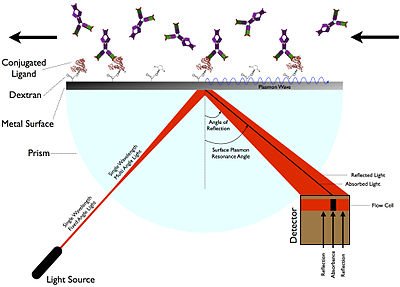
Surface plasmon resonance (SPR) is a phenomenon that occurs where electrons in a thin metal sheet become excited by light that is directed to the sheet with a particular angle of incidence, and then travel parallel to the sheet. Assuming a constant light source wavelength and that the metal sheet is thin, the angle of incidence that triggers SPR is related to the refractive index of the material and even a small change in the refractive index will cause SPR to not be observed. This makes SPR a possible technique for detecting particular substances (analytes) and SPR biosensors have been developed to detect various important biomarkers.[1][2]
- ^ Zhu, Xiaoli; Gao, Tao (2019-01-01), Li, Genxi (ed.), "Chapter 10 - Spectrometry", Nano-Inspired Biosensors for Protein Assay with Clinical Applications, Elsevier, p. 253, ISBN 978-0-12-815053-5, retrieved 2023-01-17
- ^ Marques Lameirinhas, Ricardo A.; N. Torres, João Paulo; Baptista, António; Marques Martins, Maria João (2022). "A new method to analyse the role of surface plasmon polaritons on dielectric-metal interfaces". IEEE Photonics Journal. 14 (4): 1–9. Bibcode:2022IPhoJ..1481967L. doi:10.1109/JPHOT.2022.3181967.